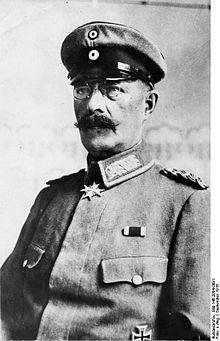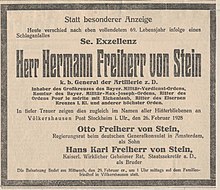Hermann Freiherr von Stein

Dietrich Karl Hermann Freiherr von Stein (born February 11, 1859 in Ansbach , † February 26, 1928 in Völkershausen ) was a Bavarian general of the artillery in the First World War .
Life
family
He was the son of the landowner Bernhard Ferdinand Freiherr von Stein zu Nord- und Ostheim and his wife Luise, née Freiin Löw von und zu Steinfurt . The German politician Hans Karl von Stein zu Nord- und Ostheim was his younger brother.
Stein married Karoline (Lina) Marie Dorotheé Valentine Josepha von Heckel (1860–1927) on October 6, 1885 in Nuremberg . The marriage produced a son.
Military career
After graduating from the Humanist High School , Stein joined the 1st Field Artillery Regiment of the Bavarian Army on October 1, 1878 as a one-year volunteer . On March 21, 1879 he was promoted to Portepéefähnrich, on March 17, 1881 to Second Lieutenant. From 1886 to 1888 he took part in a training course at the equitation institute. From 1889 to 1893 he was a department adjutant, during which time (1890) he was promoted to prime lieutenant . In 1895 Stein was promoted to captain and appointed battery chief. In November 1897 he was placed à la suite of his regiment, he was then adjutant at the General Command of the II Army Corps and in September 1901 promoted to major. In mid-February 1902 he was appointed commander of the 2nd Division of the 7th Field Artillery Regiment . At the same time, Stein was also a member of the senior study and examination committee. On May 25, 1906 he took command of the 4th field artillery regiment "König" , was promoted to lieutenant colonel in October and at the same time sent to Berlin the following year as a member of the commission for the revision of the field artillery drill regulations. On April 28, Stein gave up the regiment, was promoted to the War Ministry as head of department and promoted to colonel in February 1909 . On October 23, 1910 he was appointed commander of the 1st Field Artillery Brigade and promoted to major general in 1912 .
First World War
In the first months of the World War Stein supported the 1st Infantry Division with his brigade in the battles in Lorraine , in front of Nancy - Épinal , on the Somme and at the end of 1914 near Péronne . On September 10, 1914, he was promoted to lieutenant general, leaving his position as brigade commander. After being wounded in the meantime, Stein took command of the 8th Reserve Division on January 20, 1915 . In the battle for the Reichackerkopf from February 19 to March 20, 1915 (1st battle near Munster), he managed to rise and hold with reserve infantry regiments that had hardly been battle-tested.
At the beginning of June 1915 his division was transferred to the Eastern Front in Radymno , where it was used as flank cover for the 11th Army . Stein himself took offensive action and advanced in the battle from Oleszyce and Dachnow to Swidnica. At the end of June 1915 he returned with his division to the Vosges , where he was able to maintain the positions he had won in the spring in heavy defensive battles from July 20 to October 10, 1915 (2nd battle near Munster).
In the Battle of the Somme in 1916, Stein and his division fought over the village of Maurepas, which was initially captured by the French on July 30, 1916. He succeeded in compensating for all the loss of terrain by mid-August 1916 and then helping out with the neighboring divisions. For this he received the Knight's Cross of the Military Max Joseph Order No. 134 "because of his extraordinarily purposeful, far-sighted and successful leadership performance in the heavy battles on the Somme in the area of Maurepas in July and August 1916, which was expressed in bold, decisive decisions ".
In November 1916, the division was transferred to the Romanian theater of war in the Eastern Carpathians, where Stein was initially supposed to break into Wallachia via the Ojtoz Pass . The attack was canceled to stop a Russian break-in into the Austro-Hungarian positions in the Gyergyo Mountains and the Gyimes Pass.
On January 12, 1917 Stein became the commanding general of III. Army Corps appointed. Initially used in trench warfare in French Flanders , his corps took part in the spring battle at Arras as part of the 4th Army and replaced the I. Reserve Corps on May 10, 1917 . It was possible to repel the attacks by English troops, which were carried out at great expense, and to establish a stable front line by retaking Fresnoy. After that, from the end of May 1917, the corps was in front of Ypres , where the main thrust of the enemy was expected in the course of the Third Battle of Flanders . For the next three months Stein withstood the British attacks until the corps was relieved on September 10, 1917. As the 9th Bavarian officer, he was awarded the Commander's Cross of the Military Max Joseph Order, “because he was the leader of the Ypres group in the Battle of Flanders through particularly careful, purposeful preparation and excellent implementation of the defensive battles, which his exemplary personal Influence on the troops were influenced, has excelled. "
Then the general command of III. Corps subordinated to the 14th Army and transferred to Italy. There Stein had his troops deployed on both sides of Tolmein until October 24, 1917 and advanced to the Piave in a one-week victorious run until the end of November 1917 as part of the Battle of Karfreit . On December 14, 1917, stone was placed à la suite of the 4th Field Artillery Regiment. The corps then fought at Artois over the turn of the year 1917/18 . On February 28, 1918 Stein was promoted to general of the artillery. Now subordinate to the 17th Army , he took part with his general command in the Michael Battle and the George Battle , whereby all attacks came to a standstill by the end of April 1918 because of the tough resistance of the English and their own heavy losses.
Under the leadership of the 9th Army succeeded in the late summer of 1918 the III. Corps between Oise and Aisne to move the front back in an orderly manner and to prevent the enemy from breaking through. From the beginning of September 1918 back under the 17th Army, the III. Corps deployed on the Dutch border. At the beginning of November 1918, the general command was in the Antwerp-Maas position between Antwerp and Termonde . From there, after the Armistice at Compiègne , Stein led his troops back home via Liège and Aachen .
On December 29, 1918 it was put up for disposal .
In addition to the medals mentioned , Stein received, among other things, the oak leaves for the Pour le Mérite , the order of the Iron Crown 1st class with war decoration, the Grand Cross of the Order of Military Merit with swords, the Order of the Red Eagle 2nd class with star and swords, the Commander's Cross 1st class of Ernestine House Order and the Knight's Cross of the Order of Merit of the Bavarian Crown .
Stein died on February 26, 1928 in Völkerhausen and rests in the family crypt there. The General von Stein barracks in Freising was named after him.
literature
- Konrad Krafft von Dellmensingen , Friedrichfranz Feeser : The Bavaria book of the world wars 1914-1918. Volume I, Chr.Belser AG, publishing house, Stuttgart 1930.
- Karl-Friedrich Hildebrand, Christian Zweng: The knights of the order Pour le Mérite of the First World War. Volume 3: P-Z. Biblio Verlag, Bissendorf 2011, ISBN 3-7648-2586-3 , pp. 347-349.
- Rudolf von Kramer, Otto Freiherr von Waldenfels: The royal Bavarian military Max-Joseph-Order. Self-published by the kb Militär-Max-Joseph-Order, Munich 1966.
Web links
Individual evidence
- ↑ Rudolf von Kramer, Otto Freiherr von Waldenfels: The royal Bavarian military Max Joseph order. Self-published by the kb Military Max Joseph Order. Munich 1966, p. 153f.
- ↑ Rudolf von Kramer, Otto Freiherr von Waldenfels: The royal Bavarian military Max Joseph order. Self-published by the kb Militär-Max-Joseph-Order, Munich 1966, p. 195.
| personal data | |
|---|---|
| SURNAME | Stein, Hermann Freiherr von |
| ALTERNATIVE NAMES | Stein, Dietrich Karl Hermann Freiherr von (full name) |
| BRIEF DESCRIPTION | Bavarian general of the artillery in the First World War |
| DATE OF BIRTH | February 11, 1859 |
| PLACE OF BIRTH | Ansbach |
| DATE OF DEATH | February 26, 1928 |
| Place of death | Völkershausen |
